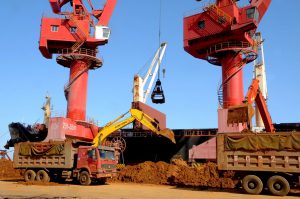China Central Television’s military channel has reported that the Pentagon is planning to use a law from the 1950s to ‘militarise’ rare earth production in the US.
According to the Chinese report, the US government will not hesitate to use the National Defense Production Act to accelerate domestic production of rare earths in order to achieve self-sufficiency in these mineral elements.
Rare earths are crucial in military technology. It reportedly takes 417 kilograms of rare earths to manufacture an F-35 fighter jet, and four tonnes of rare earth minerals for a Virginia-class nuclear submarine.
At present, 80% of rare earth mineral products in the United States are imported from China, while the rest are imported indirectly from China through other countries. The US does produce its own rare earths, but reportedly sends them to China for processing.
China Reference News Network reported on October 7 that the US media said that the US government is stepping up its efforts to obtain minerals that are essential to modern technology, but the supply of which is dominated by China. Mining companies have warned that this “monopoly” may take years to break.
A report by The Wall Street Journal, run on its website on October 5, said that in recent years the United States and other Western countries have invested in projects and approved licenses to exploit these resources, which are essential for the production of electric cars, mobile phones and wind turbines.
But as these countries are still far behind China, they are accelerating their pace of development.
Last week President Trump was reported to have signed an executive order declaring a ‘state of emergency’ and authorising the use of the National Defense Production Law to accelerate the development of mineral resources. This law was used earlier this year to speed up the production of medical supplies to manage the coronavirus epidemic.
The report noted that on Monday the Irish-based Science and Techmet Ltd said that the state-sponsored US International Development Finance Corporation invested $25 million in the company’s production and recycling of battery metal materials such as nickel and cobalt.
Miners and analysts welcomed these measures, but they warned that mining will take about 10 years, and Western countries also need to develop the ability to process these resources into materials for final products.
‘Overwhelming Dominance’
Techmet Limited CEO Brian Menell said: “Especially to change China’s overwhelming dominance of rare earths, this is a process that takes many, many years. There is no shortcut.”
The report pointed out that rare earth elements used in batteries and electronic devices are some of 35 minerals that the US government considers vital to the economy and national security. Of the 35 key minerals, 14 are not produced in the United States.
These include gallium, an element used in light-emitting diodes and semiconductors in mobile phones. Critical minerals are also used in low-tech sectors. China supplies half of the American barite, and barite is used in hydraulic fracking technology.
The report also pointed out that China’s dominant position in many of these minerals has been established because of their abundant reserves in China.
It noted that until the 1980s, the United States had been the world’s largest rare earth producer and created rare earth processing technology, but now the United States has only one rare earth production mine – the Mountain Pass rare earth mine in California, and there is no processing plant in the US.
Another report on Netease said academics and others are petitioning the Chinese government to stop exporting rare earths. The amount of rare earths exported is declining rapidly every month.
It noted that rare earths are also known as “industrial vitamins” because they are among the most precious mineral resources. Rare earths are also widely used in petroleum, the chemical sector, metallurgy, for textiles and ceramics, glass, magnet materials and other fields.
China’s rare earth reserves account for 23% of the world’s share and but supply 90% of the global market. China also has the world’s most complete rare earth industry chain, which means in order to make full use of the rare earths mined in various countries, they must come to China for processing, otherwise a lot of resources will be wasted.
Both the United States and Russia are making efforts to catch up. The amount of rare earths produced in the United States has reached 26,000 tonnes a year, but of most of this – 19,353 tonnes were shipped to China for processing.
Russian demand for rare earths is also high. Although Russia has the world’s second largest rare earth reserves, its domestic rare earth production is low and the initial produce is also transported to China for processing.
It is understood that Moscow has invested heavily in the domestic rare earth industry and even reduced mining taxes and other policies to create an incentive to generate more production.
• Chris Gill
This report was updated for style purposes on Jan 11, 2022.
























